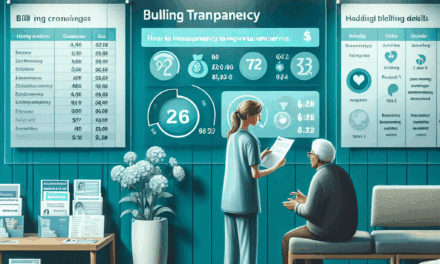VA Ends Vendor Contracts That Could Have Supported EHR Modernization
The U.S. Department of Veterans Affairs (VA) has recently made headlines by terminating several vendor contracts that were intended to support the modernization of its Electronic Health Record (EHR) system. This decision has raised questions about the future of EHR modernization within the VA, which is crucial for improving healthcare delivery to millions of veterans. In this article, we will explore the implications of this decision, the challenges faced in EHR modernization, and the potential paths forward for the VA. We will delve into five key subtopics that provide a comprehensive understanding of the situation.
Understanding the VA’s EHR Modernization Efforts
The VA’s EHR modernization initiative aims to replace its outdated VistA system with a more integrated and user-friendly platform. This effort is part of a broader strategy to enhance healthcare delivery and improve patient outcomes for veterans. The modernization project began in 2017, with the VA selecting Cerner Corporation as its primary vendor to implement a new EHR system.
However, the journey has been fraught with challenges. The VA’s decision to terminate vendor contracts raises concerns about the future of this critical initiative. The following points highlight the key aspects of the VA’s EHR modernization efforts:
- Background of VistA: The Veterans Health Information Systems and Technology Architecture (VistA) has been in use since the 1980s. While it has served veterans well over the years, it is increasingly seen as outdated and unable to meet the demands of modern healthcare.
- Selection of Cerner: In 2017, the VA awarded a $10 billion contract to Cerner to implement a new EHR system. This decision was aimed at creating a more interoperable system that could seamlessly share information with the Department of Defense (DoD) and other healthcare providers.
- Implementation Challenges: The transition to the new system has faced numerous hurdles, including technical difficulties, resistance from staff, and concerns about data security.
- Impact on Veterans: The success of the EHR modernization project is critical for improving the quality of care for veterans. A modern EHR system can enhance care coordination, reduce errors, and improve patient outcomes.
- Future Prospects: The termination of vendor contracts raises questions about the future of the EHR modernization initiative. Stakeholders are concerned about potential delays and the impact on veterans’ healthcare.
The Implications of Terminating Vendor Contracts
The VA’s decision to end vendor contracts that could have supported EHR modernization has significant implications for the agency and the veterans it serves. This section will explore the potential consequences of this decision, including operational, financial, and strategic impacts.
One of the most immediate implications is the potential delay in the implementation of the new EHR system. The contracts that were terminated were designed to provide essential support services, including software development, training, and technical assistance. Without these services, the VA may struggle to meet its implementation timeline.
Financially, the termination of vendor contracts could lead to increased costs in the long run. The VA may need to invest additional resources to find new vendors or to bring the necessary expertise in-house. This could divert funds from other critical areas of veteran care, exacerbating existing challenges within the healthcare system.
Strategically, the decision raises questions about the VA’s commitment to EHR modernization. Stakeholders, including veterans, healthcare providers, and policymakers, may lose confidence in the VA’s ability to deliver on its promises. This could lead to increased scrutiny from Congress and other oversight bodies, further complicating the agency’s efforts to modernize its healthcare delivery system.
Moreover, the termination of vendor contracts could hinder the VA’s ability to achieve interoperability with the DoD and other healthcare systems. Interoperability is a key goal of the EHR modernization initiative, as it allows for seamless sharing of patient information across different healthcare providers. Without the necessary support, the VA may struggle to achieve this goal, ultimately impacting the quality of care for veterans.
Challenges in EHR Modernization
The VA’s EHR modernization initiative faces a myriad of challenges that have contributed to the recent decision to terminate vendor contracts. Understanding these challenges is crucial for grasping the complexities of the situation and the potential paths forward for the VA.
One of the primary challenges is the resistance to change among VA staff. Many healthcare providers are accustomed to the VistA system and may be hesitant to adopt a new EHR platform. This resistance can manifest in various ways, including reluctance to participate in training sessions, skepticism about the new system’s capabilities, and concerns about the potential for disruptions in patient care during the transition.
Another significant challenge is the technical complexity of implementing a new EHR system. The VA’s healthcare network is vast and diverse, encompassing numerous facilities and services. Integrating a new EHR system across this network requires careful planning, coordination, and execution. Technical difficulties, such as data migration issues and software bugs, can further complicate the implementation process.
Data security is also a critical concern in the context of EHR modernization. The VA handles sensitive patient information, and any breaches or vulnerabilities in the new system could have serious consequences. Ensuring robust cybersecurity measures are in place is essential to protect veterans’ data and maintain trust in the VA’s healthcare system.
Additionally, funding constraints pose a significant challenge to EHR modernization efforts. The VA’s budget is subject to political negotiations and may not always align with the financial needs of the modernization initiative. Limited funding can hinder the agency’s ability to invest in necessary resources, such as training programs and technical support.
Finally, the need for interoperability with other healthcare systems adds another layer of complexity to the EHR modernization initiative. Achieving seamless data sharing between the VA, DoD, and other healthcare providers is essential for improving care coordination and patient outcomes. However, differing systems and standards can create barriers to achieving this goal.
Case Studies: Lessons from Other Healthcare Organizations
To better understand the challenges and opportunities associated with EHR modernization, it is helpful to examine case studies from other healthcare organizations that have undergone similar transitions. These examples can provide valuable insights for the VA as it navigates its own modernization efforts.
One notable case is that of the Department of Defense (DoD), which has also been working to modernize its EHR system. The DoD selected the same vendor, Cerner, to implement its MHS Genesis system. While the DoD has faced its own set of challenges, it has made significant progress in achieving interoperability with the VA. This collaboration has allowed for improved care coordination for service members and veterans, demonstrating the potential benefits of a unified EHR system.
Another example is the University of California Health System, which successfully transitioned to a new EHR platform. The organization implemented a comprehensive change management strategy that included extensive training for staff, stakeholder engagement, and ongoing support. By prioritizing communication and collaboration, the University of California Health System was able to minimize resistance and ensure a smoother transition to the new system.
In contrast, the implementation of the EHR system at the New York City Health + Hospitals system faced significant challenges. The organization struggled with staff resistance and technical difficulties, leading to delays and increased costs. This case highlights the importance of addressing staff concerns and providing adequate training and support during the transition process.
These case studies underscore the importance of strategic planning, stakeholder engagement, and effective change management in EHR modernization efforts. By learning from the experiences of other organizations, the VA can better navigate its own challenges and work towards a successful implementation of its new EHR system.
Potential Paths Forward for the VA
Despite the challenges and setbacks associated with EHR modernization, there are several potential paths forward for the VA. By adopting a proactive and strategic approach, the agency can work towards successfully implementing its new EHR system and improving healthcare delivery for veterans.
One potential path is to re-evaluate the vendor selection process. The VA may consider engaging with additional vendors or exploring alternative solutions that can better meet its needs. This could involve conducting a thorough assessment of the current EHR landscape and identifying vendors with proven track records in similar implementations.
Another important step is to prioritize staff training and engagement. The VA should invest in comprehensive training programs that address staff concerns and provide the necessary skills to navigate the new system. Engaging healthcare providers in the decision-making process can also foster a sense of ownership and commitment to the modernization initiative.
Additionally, the VA should focus on enhancing its change management strategy. This includes establishing clear communication channels, providing ongoing support, and addressing any technical difficulties that arise during the implementation process. By fostering a culture of collaboration and adaptability, the VA can mitigate resistance and ensure a smoother transition to the new EHR system.
Furthermore, the VA should prioritize data security and interoperability as key components of its modernization efforts. Implementing robust cybersecurity measures and ensuring seamless data sharing with the DoD and other healthcare providers will be essential for improving care coordination and patient outcomes.
Finally, the VA should seek to secure adequate funding for its EHR modernization initiative. This may involve advocating for increased budget allocations or exploring public-private partnerships to support the implementation process. By ensuring that sufficient resources are available, the VA can better position itself for success in its modernization efforts.
Conclusion
The VA’s decision to terminate vendor contracts that could have supported EHR modernization has significant implications for the agency and the veterans it serves. As the VA navigates the complexities of this initiative, it is essential to understand the challenges it faces and the potential paths forward.
By learning from the experiences of other healthcare organizations, prioritizing staff engagement and training, and focusing on data security and interoperability, the VA can work towards successfully implementing its new EHR system. Ultimately, the success of EHR modernization is critical for improving healthcare delivery and outcomes for millions of veterans across the country.
As stakeholders continue to monitor the situation, it is crucial for the VA to remain committed to its modernization efforts and to address the challenges that lie ahead. The future of veterans’ healthcare depends on the successful implementation of a modern, integrated EHR system that meets the needs of both providers and patients.





